Municipal Auditorium may refer to:

Seventy-First Classical Middle School (SFCMS) is a middle school within the Cumberland County district. It is located at 6830 Raeford Road in Fayetteville, North Carolina. It serves students from grades 6 through 8. The school's current principal is Patricia Ramos.
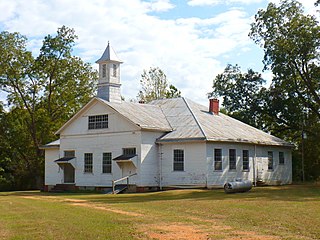
Prairie Mission, also known as the Prairie Mission School and Prairie Institute, was a historic African American school in the community of Prairie, Alabama. The school is the only survivor of the six original Presbyterian mission schools that once operated in Wilcox County. It was placed on the Alabama Register of Landmarks and Heritage on July 22, 1991 and subsequently on the National Register of Historic Places on October 29, 2001, due its significance to African American history.

Liberty Colored High School is a former high school for African-American students in Liberty, South Carolina during the period of racial segregation. It originally was called Liberty Colored Junior High School. The building is now a community center known as the Rosewood Center. It is at East Main Street and Rosewood Street in Liberty. The school was built in 1937 on the site of a Rosenwald school that had burned down. Because of its role in the education of local African-American students, it was named to the National Register of Historic Places on April 18, 2003.

Burroughs School, also known as Burroughs Graded School, is a historic school located at Conway in Horry County, South Carolina. It was built in three phases between 1905 and 1923. The earliest portion of the building was built as an elementary school and has three main portions of eleven bays. It features a one-story, hip roof porch supported by six Ionic order columns with Scamozzi capitals. About 1915 a two-story hipped classroom wing was added and in 1923 four classrooms and an auditorium was added to the complex.
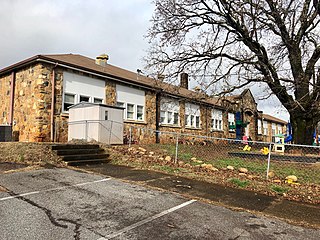
The Webster Rock School is an historic school building located NC 116 / Main St., at Webster, Jackson County, North Carolina. It was built between 1936 and 1938 by the Works Progress Administration, and is one story with hip roof utilitarian building, constructed of native "river rock" in colors of tan and brown. It has an "E"-shape plan and has a 13 bay front facade. The school originally contained an auditorium, cafeteria, kitchen and eight classrooms.
Charles Christian Hook (1870–1938) was an American architect. He was also the founder of FreemanWhite, Inc. a Haskell Company (1892), the oldest practicing firm in North Carolina and currently the 11th oldest architecture firm in the United States.
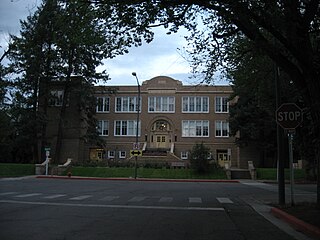
Durango High School, also known as the Durango 9-R Administration Building, is a former school in Durango, Colorado. It is listed on the National Register of Historic Places and the Colorado State Register of Historic Properties. The building opened in 1917, and served as a high school until 1976, after which it became the district administration building.
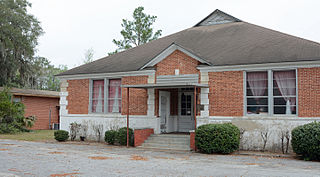
Lanier County Auditorium and Grammar School are two historic buildings in Lakeland, Lanier County, Georgia, on East Church Avenue. They were built in 1925 under architect Lloyd Greer (1885-1952). Both buildings are one story tall and made of brick and concrete. The school building has a central hall with five classrooms on one side and three on the other. The auditorium seats 600 and the front of the building has two additional classrooms. Some modernization of the plumbing, heating, and electrical systems took place after 1940. They are the only remaining buildings from the consolidation of schools which took place after the county was formed in 1920. The buildings were added to the National Register of Historic Places on April 10, 1986.

Bath School is a historic school complex located at Bath, Beaufort County, North Carolina. It was built in phases between 1918 and 1966, and consists of two classroom buildings and a classroom and auditorium building connected by a two-story hyphen. Each section is a two-story, brick structure with a hipped roof and Colonial Revival style design details. A kitchen addition was built in 1966. Also on the property are the contributing 1 1/2-story vocational building constructed in 1939 with funds from the Public Works Administration (PWA), one-story shop building built in 1948, and flagpole.

Hickory Municipal Building is a historic municipal building located at Hickory, Catawba County, North Carolina. It was built in 1920-1921, and is a two-story brick building in the Classical Revival style. It has a three-story auditorium. The front facade features a one-story limestone portico, protecting the center entrance. In 1977, the city administrative offices were relocated to the new city hall. It houses the Hickory Community Theatre.

Church Street School is a historic school building for African-American students located at Thomasville, Davidson County, North Carolina. It was built in 1935-1937, and is a two-story, "T"-shaped, Colonial Revival style brick building. A two-story auditorium projects from the rear of the main building. Two-story wings built in 1951 flank the original building. A gymnasium was built the same year. Some funding for school construction was provided by the Public Works Administration.

Dallas Graded and High School, also known as the Church Street School, is a historic school building located at Dallas, Gaston County, North Carolina. The main school building was built in 1923-1924, and is a two-story, seven bay, "T"-plan Classical Revival style red brick school. It has a flat roof with parapet and features a three-bay porticoed entry pavilion. It has an eight classroom addition built in 1951.

Enfield Graded School, also known as Enfield Middle School, is a historic school building located at Enfield, Halifax County, North Carolina. It was designed by architect Frank B. Simpson and built in 1950. It is a two-story, Colonial Revival style brick building. The "H"-shaped building consists of a large two-story central block, projecting two-story flanking wings, a one-story auditorium, and a one-story kitchen addition. Also on the property are the contributing brick gymnasium (1951), concrete block agricultural building (1952), and adjacent athletic fields.

Harnett County Training School, also known as Harnett High School, is a historic school complex for African-American students located at Dunn, Harnett County, North Carolina. The complex was built between 1922 and 1956, and consists of one two-story and five single-story brick buildings. They include a gable front combined Gymnasium/Auditorium (1948); the two-story, 14 teacher, flat-roofed, Colonial Revival-style Rosenwald-funded Harnett County Training School (1922); a detached brick boiler room (1950); two, one-story, flat-roofed Library and Office Building and Cafeteria buildings (1956); and a one-story, flat-roofed Rosenwald-funded classroom annex added in 1927, now designated the Education Building.

C. S. Brown School Auditorium, also known as Brown Hall, is a historic school auditorium and national historic district located at Winton, Hertford County, North Carolina. It was built in 1926, and is a one-story stuccoed tile block building in the Colonial Revival style. It consists of a five-bay central pavilion with hip roof and flanking classroom wings. The front facade features a pedimented portico with four original Doric order columns. It is the oldest intact and unaltered building associated with the Calvin Scott Brown School, a school for African-American students founded by Calvin Scott Brown (1859–1936).

Clayton Historic District is a national historic district located at Clayton, Johnston County, North Carolina. It encompasses 271 contributing buildings, 2 contributing sites, and 1 contributing structures in the town of Clayton. It includes notable examples of Late Victorian and Bungalow / American Craftsman style architecture and buildings dating from about 1850 to 1959. It includes commercial, residential, ecclesiastical, and educational structures. Located in the district are the separately listed Clayton Banking Company Building and the Clayton Graded School and Clayton Grammar School-Municipal Auditorium. Other notable buildings include the B.M. Robertson Mule Company stable, Mayo House, the Young House, Horne Memorial United Methodist Church, First Baptist Church of Clayton, and First Missionary Baptist Church.

Delgrado School, also known as Washington Catlett School, is a historic school building located at Wilmington, New Hanover County, North Carolina. It was built 1914, and is a one-story, Classical Revival style red brick building with a low-pitched gable and hip roof. Additions were made to the original building in 1924, 1938 and 1953 (kitchen). It was built as part of the Delgado Mill Village. The 1938 addition was built as a Public Works Administration project.
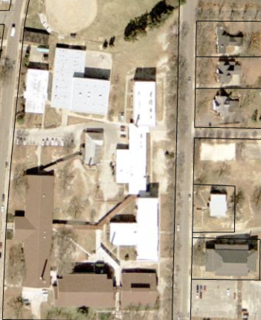
Fuquay Springs High School, also known as Fuquay-Varina Middle School, is a historic high school located at Fuquay-Varina, Wake County, North Carolina. It was built about 1925, and is a two-story, rectangular, flat-roofed, red brick, Colonial Revival style building. It has a one-story rear auditorium wing. The school was connected by an open breezeway to a cafeteria building built about 1948. In the early 2000s the campus underwent a renovation and addition by the Wake County Public School System which consisted in converting the existing 1925 building into an administration hall along with a few classrooms. The 1948 construction was demolished along with a few other buildings. The renovation took place to address the issue of students having to go outside to switch classes, so the buildings on the north end of the campus with the exception of the gym was demolished. The new construction ties the rest of the buildings from the north end of the campus to the south end opening in 2003.

Washington Magnet Elementary School is a historic school and building located at Raleigh, Wake County, North Carolina. It was built in 1923–1924 to serve African-American students in Raleigh and is now a magnet elementary school.



















